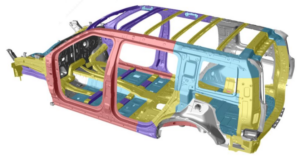The body structure of the 2011 Seat León is unitised made from galvanised steel and uses 50% more high-strength and ultra-high-strength steels than in the previous León, 63% of the steels used are high-strength and 5% are ultra-high-strength. The sheet-metal components that make up the top section of the body (which are the roof, side panelling, pillars and side skirts) as well as the protective bars in the doors are mostly high-strength steels. The frame structure in the lower section of the new León is also composed of a high percentage of high-strength steels.
One manufacturing process that I have cover on this site before is hot stamping or hot pressing. The B-pillar is built from ultra-high-strength steels which are also manufactured using a hot-pressing process. This technology deviates from conventional pressing and replaces it with a combination of techniques, including heating the sheet-metal blank prior to forming it in the press. After the blank is formed a refrigeration system built into the stamping press cools the part which is trimmed to its’ final shape by laser-cutting.
Laser welding is another process that was covered a while back. The tremendous static rigidity of the new León has been achieved by assembling the body using 5,100 mm of laser welding and 5,000 mm of structural bonding. Assembly furthermore involves applying 3,700 resistance-welding spots as well as 3,200 mm of arc welding.
 Boron Extrication An in-depth look into vehicle extrication and rescues involving today's automobiles
Boron Extrication An in-depth look into vehicle extrication and rescues involving today's automobiles








